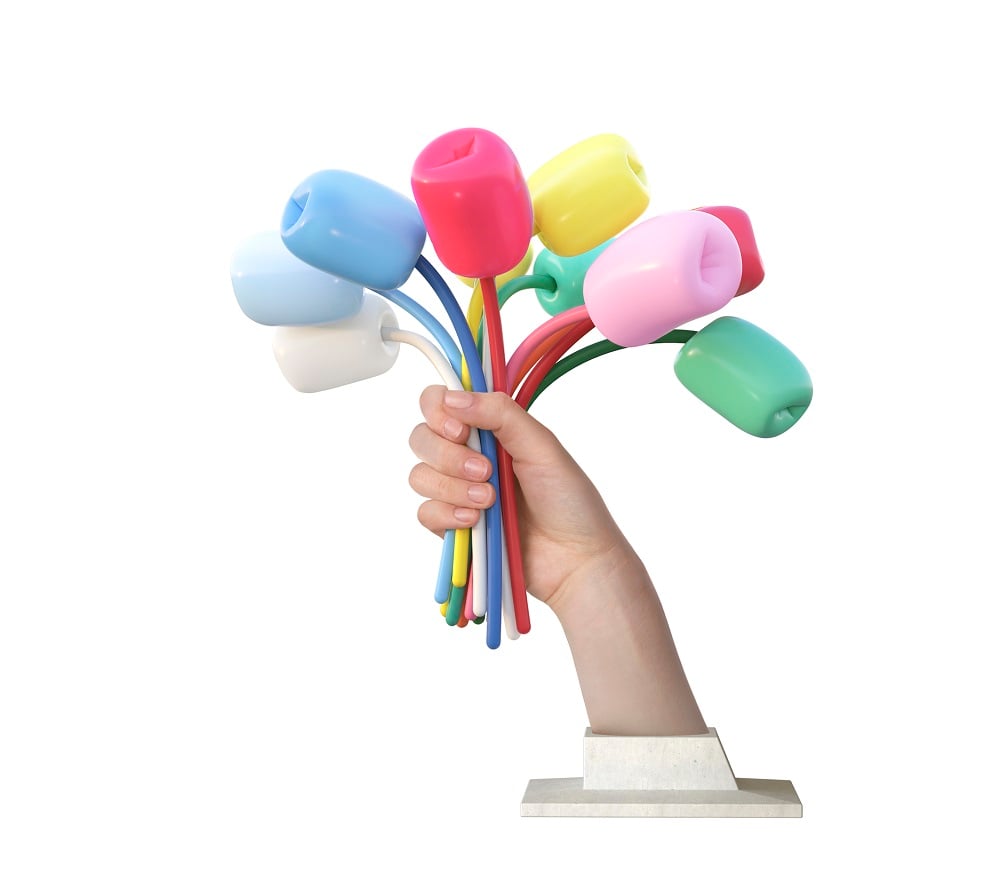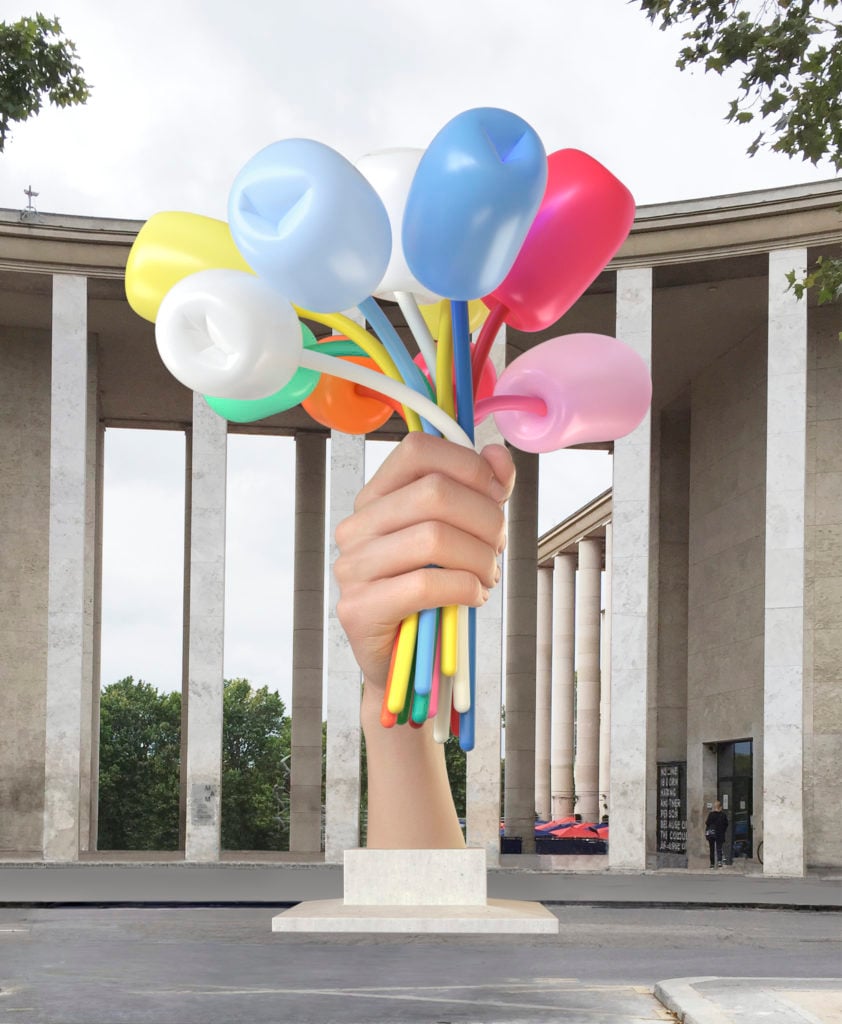This past Sunday, January 21, French cultural personalities penned an open letter in the daily newspaper Libération urging the city not to go ahead with the planned installation of the gigantic sculpture gifted by Jeff Koons in the wake of the Paris attacks.
Twenty-four artists, museum workers, collectors and politicians, including artists Christian Boltanski and Tania Mouraud, filmmaker Olivier Assayas, and the former Minister of Culture, Frédéric Mitterrand, have put their name to the letter deeming Koons’s gift symbolically inappropriate, undemocratic, and architecturally, patrimonially, artistically, financially, and technically “shocking.”
Bouquet of Tulips, a massive sculpture depicting a hand offering a bunch of multicolored balloon tulips, was gifted to the city on November 21, 2016, just over a year after the Paris terror attacks on November 13, 2015, and is currently being completed in a German factory. Meant as a symbol of optimism and solidarity after the terror attacks in 2015, the sculpture purposefully recalls the Statue of Liberty raising her torch, and is due to be permanently installed in Tokyo Square in front of the prestigious Palais de Tokyo.

Jeff Koons Bouquet of Tulips (2016). © Jeff Koons. Courtesy Noirmontartproduction.
The open letter, translated by artnet News, calls for the project to be abandoned, citing several reasons. First and foremost, the signatories write, the gift is unsuitable symbolically given its positioning far from the Stade de France, Bataclan concert venue, or nearby businesses hit by the 2015 attacks that took 130 lives. “The choice of work, and above all its placement somewhere without a single connection to the tragic events it evokes and their location, seems surprising at the least, if not opportunistic and even cynical.”
Further, they write, the gift is democratically problematic. “If an artwork of such importance needed to be put in this particularly cultural and historically prestigious place, shouldn’t we have proceeded by launching a call for submissions, as is customary, to open this opportunity up to players in the French scene?”
Then, they opine, the sculpture is unseemly from both an architectural and patrimonial perspective because of its size and visual impact—the sculpture would be 38 feet high, and weigh in at 35 tons—as well as its location in front of the columns of the city’s modern art museum, the Palais de Tokyo, and the view of the Eiffel Tower.
The signatories go on to condemn the sculpture—and its author—artistically, writing that “while he may have been brilliant and inventive in the 1980s, Koons has since become the emblem of an industrial, spectacular and speculative art.”
They continue, explaining that “[Koons’s] studio and dealers are hyper-luxury multinationals, and offering them such prominent visibility and recognition amounts to publicity or product placement, and would be particularly out of place in this very touristy area between two major cultural institutions devoted to emerging artists and the French artistic scene.”
Then, they argue, it is financially unjustifiable. Koons only gifted his idea; the €3.5 million ($4.3 million) execution and installation costs fall to the French State and taxpayers, as well as wealthy patrons. Further, the preliminary work required to reinforce the basement of the Palais de Tokyo underneath the square will put some of its spaces out of service for a long time, causing a major financial shortfall for the art center.

Jeff Koons Bouquet of Tulips (2016). © Jeff Koons. Courtesy Noirmontartproduction.
Finally, they argue, it is technically unviable. “Putting 35 tons on top of the Palais de Tokyo’s exhibition rooms is a huge mistake. Already uncertain, the safety of such a long-term undertaking is impossible to guarantee.” The signatories conclude the letter by writing that “We appreciate gifts, but free, unconditional and without ulterior motives.”
artnet News has reached out to the French ministry of culture, which is in charge of the decision-making around the installation, for comment on the matter, and is awaiting a response. The ministry has hesitated to comment on the controversial gift since the former president of the Centre Pompidou, Robert M. Rubin, called the gift a “poisoned chalice” in an op-ed in Le Monde at the end of July last year.
See the full list of signatories below:
Olivier Assayas, filmmaker; Marie-Claude Beaud, Director of the New National Museum of Monaco; Marie-Laure Bernadac, Honorary General Curator; Christian Bernard, director of the Spring of September; Christian Boltanski, artist; Nicolas Bourriaud, director of Montpellier Contemporain; Emilie Cariou, MP (LREM) Vice-Chair of the Finance Committee; Stéphane Corréard, director of the Galeristes salon; Matali Crasset, industrial designer; Alexia Fabre, chief curator of Mac / Val; Estelle Francès, founder of the Francès Foundation; Alexandre Gady, president of sites and monuments; Antoine de Galbert, collector, founder of the Maison rouge; Catherine Grenier, Director of the Alberto-et-Annette-Giacometti Foundation; Marie-Laure Jousset, Honorary Chief Curator; Marin Karmitz, collector; Gaëlle Lauriot-Prévost, designer; Claire Le Restif, director of the contemporary art center Le Crédac; Gabrielle Maubrie, gallerist, founder of the association Galleries mode d’emploi; Frédéric Mitterrand, former Minister of Culture; Jean-Luc Moulène, artist; Tania Mouraud, artist; Pierre Oudart, director of the Marseille-Méditerranée College of Art and Design; Dominique Perrault, architect.











